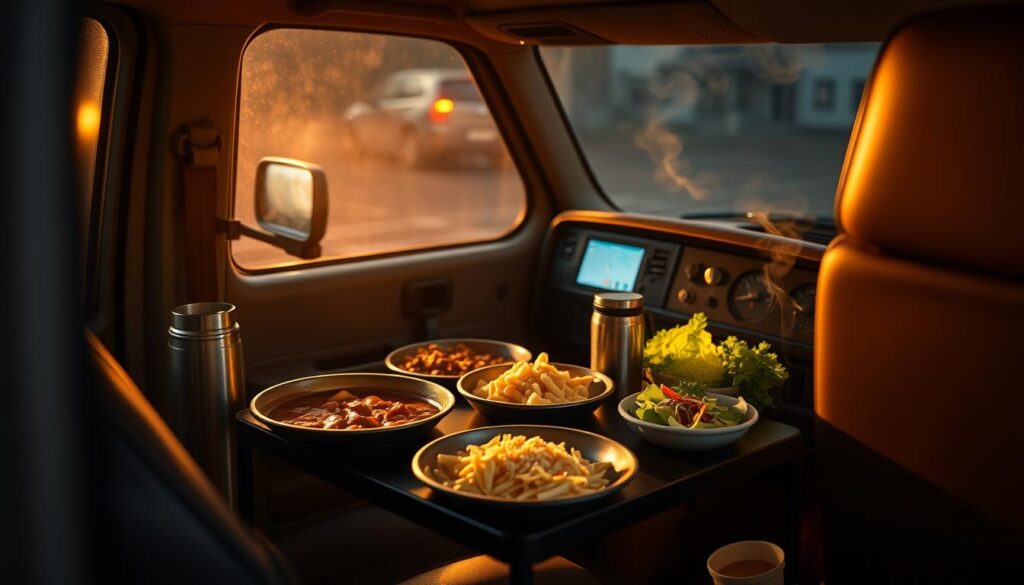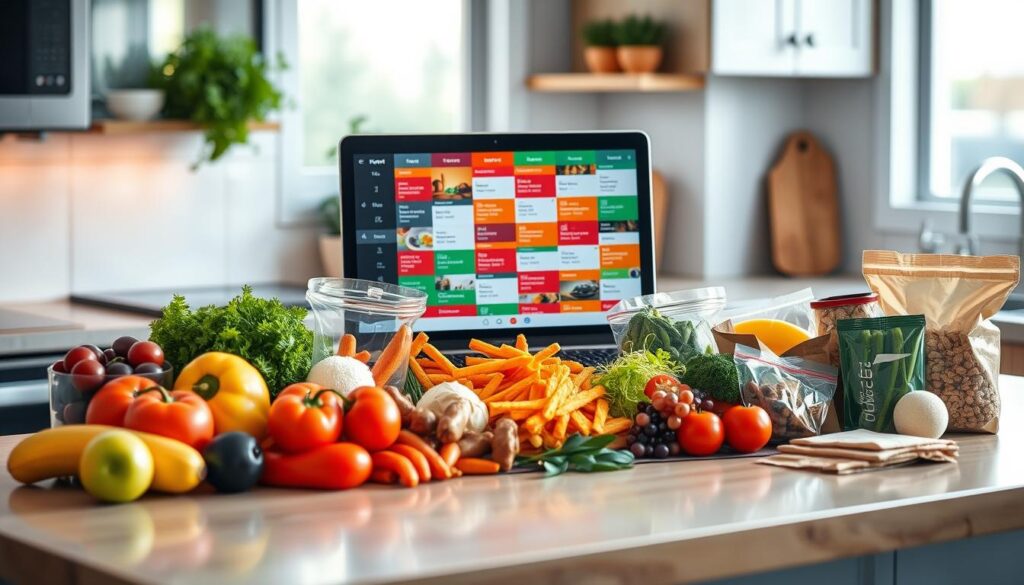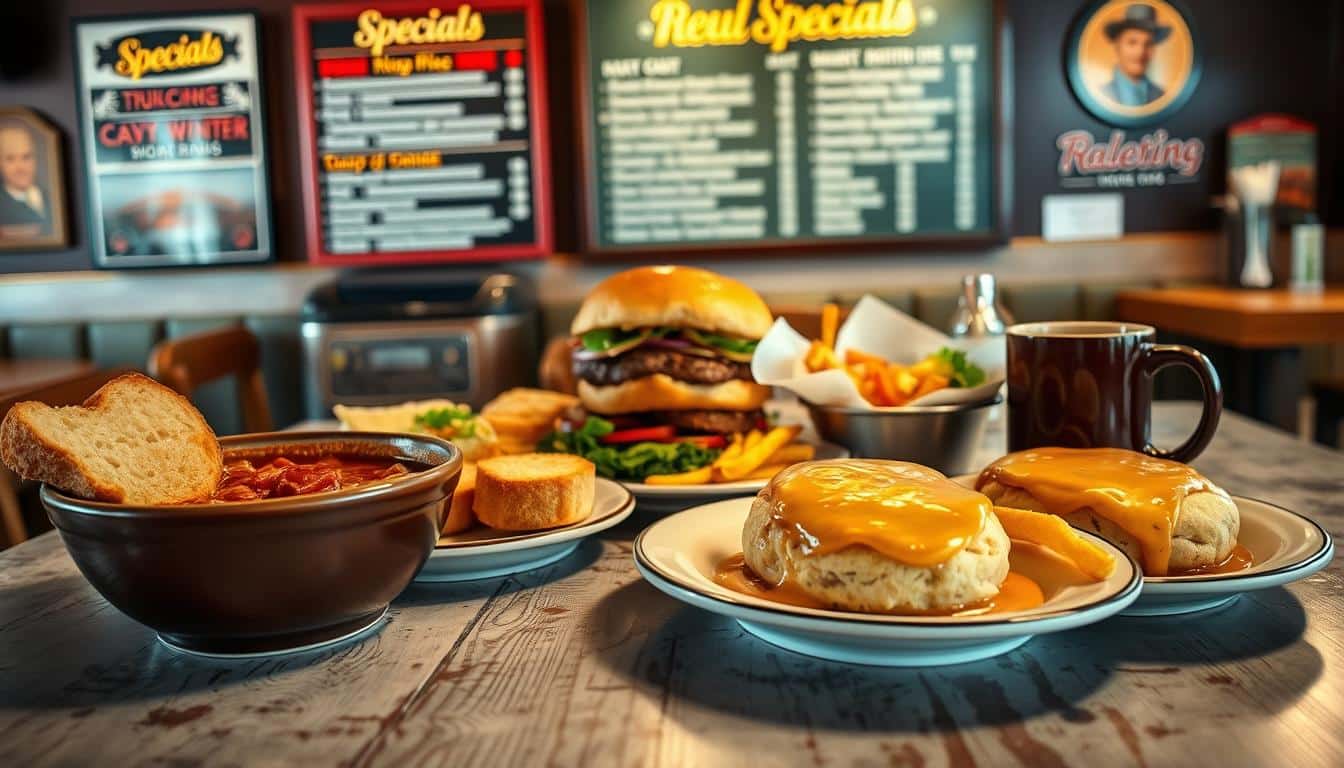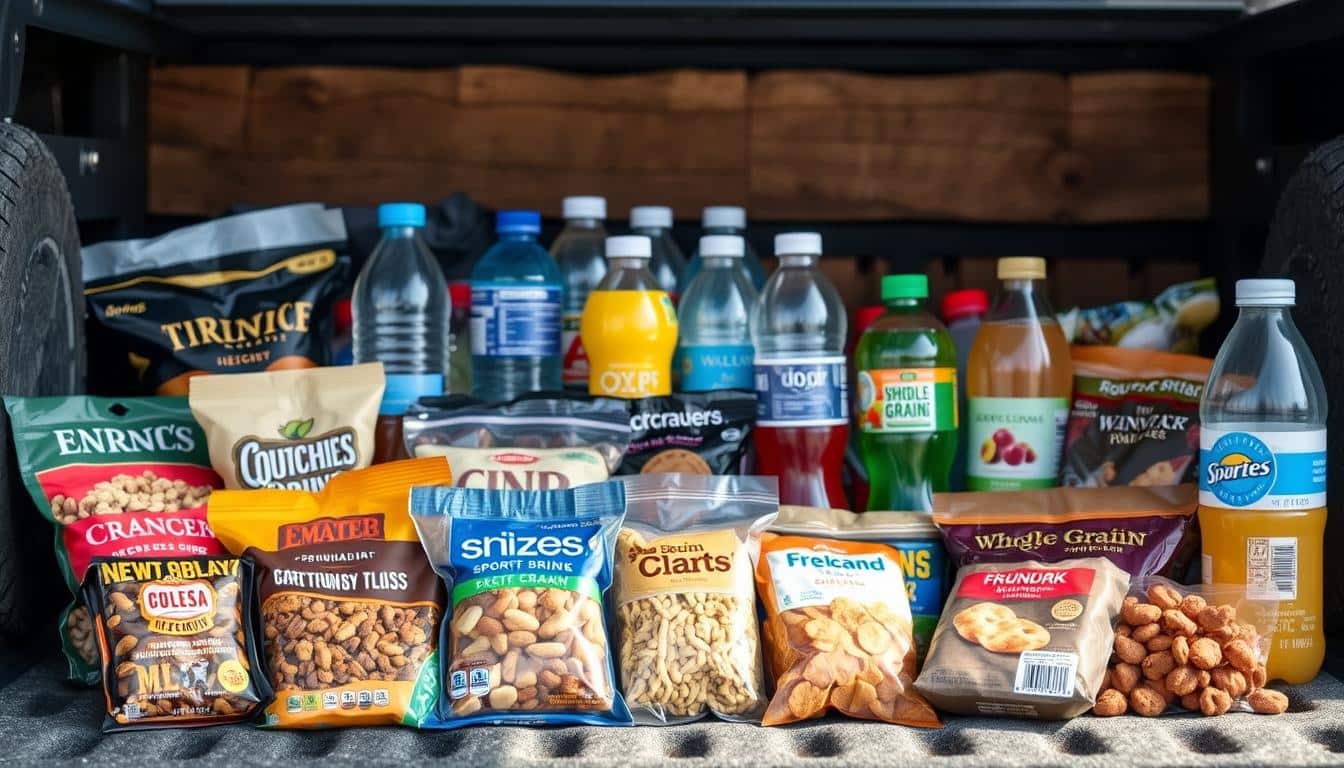Driving for hours changes your eating habits. Big trucking companies like Swift Transportation say that being on the road makes it hard to eat well. Drivers face tight schedules and don’t sleep much, which messes with their meals.
Many truckers eat fast food often because it’s quick. HMD Trucking says this can lead to serious health issues. Problems like obesity, high blood pressure, diabetes, heart disease, and some cancers become more common.
But there’s good news. Planning your meals and cooking in your truck can save you money and boost your health. Tools like thermoses, coolers, and portable cookers help you manage what you eat. You won’t need a big kitchen to make better food choices.
This guide has great tips for eating well on the road. It’s packed with easy recipe ideas and habits for truck drivers. Keep reading for advice on healthy trucker meals and more.
Why Nutrition Matters for Drivers: Health Risks and Road Realities
Driving for long hours affects more than just the path taken. The mix of long drives, not much sleep, and scarce healthy food options affect meal choices. This situation makes eating right a big challenge for those who drive for a living.
The Bureau of Labor Statistics shows that a typical truck driver needs about 1,975 calories daily. Yet, many eat too much from processed food and snacks. This overeating is linked to several health issues seen among drivers.
Common diet-related health risks for drivers
A lot of truckers deal with health problems caused by poor diet. HMD Trucking discovered 88% of drivers might get at least one disease from their diet. The CDC found around 69% of truckers are too heavy, affecting obesity levels.
- Tooth decay from too many sugary, starchy snacks.
- High blood pressure from too much salt in quick meals.
- High cholesterol due to too much saturated fat and not moving enough.
- Heart disease and stroke from eating bad fats.
- Type 2 diabetes from eating too much sugar and gaining weight.
- Osteoporosis risk because their diet messes with how they use calcium.
- Higher cancer risk from being overweight and long-term inflammation.
How driving life affects eating habits
Driving jobs make drivers choose quick, unhealthy food at diners and truck stops. Little space for storing food and no real kitchens mean less fresh veggies and fruits. Rushed schedules lead to picking meals that are salty and fatty.
Bad work hours and sitting a lot mess up how well they control hunger. Messed up sleep makes craving for sweet stuff get worse. These driving effects make sticking to healthy eating tougher.
But, when drivers make their own meals, things get better. Making simple changes to what they eat reduces calories, fat, and salt. Planning meals ahead of time helps avoid a lot of the health issues drivers face and decreases overall health risks down the road.
Practical Meal-Prep Equipment for the Cab
Small investments can change the way you eat on the road. Compact tools help drivers make healthier meals, manage serving sizes, and skip fast food. Choose equipment that suits your truck space, power availability, and cooking time.
Small appliances that make cooking possible on the road
- 12-volt cooker units let you warm up soups and meals directly in your vehicle outlet.
- Portable slow cookers cook your meals while you rest, ready for when you’re done driving.
- Lunchbox cookers and small electric skillets are great for quick meats and single-pan dishes.
- A fridge or good cooler in your truck keeps food fresh and limits fast food eating.
Essential containers and organization
- Insulated lunch bags maintain the temperature of sandwiches and salads on shorter trips.
- Divided meal containers help you control your portions of meats, grains, and vegetables.
- Thermoses keep soups and coffee warm for hours, reducing the need to stop for snacks.
- Labeling your containers, using ice packs, and pre-packing snacks helps you save time and eat regularly.
Using truck-friendly kitchen tools is a great step towards healthier eating habits. It matches well with company health initiatives like those by Swift. Begin with something simple, like a 12-volt cooker or insulated bags. Later, you might add a slow cooker or a fridge, depending on what you need and what you can afford.
Breakfast Ideas to Start Long Drives Right
Begin your day with easy, no-fuss foods that help you stay focused and fight off early hunger. Choose foods that mix proteins with slow-releasing carbohydrates. This helps keep your energy consistent as you drive. With minimal preparation and some handy gadgets, you can turn your kitchen efforts into meals perfect for the road.
Quick protein-rich breakfasts
Eggs are a top pick for a protein-packed start. Hard-boiled eggs are easy to carry, fit nicely in snack boxes, and work great with a fruit on the side.
Try making egg bakes with any leftover veggies and cheese using a lunchbox cooker. Cut them into pieces and warm them up at a truck stop microwave or in a thermos before you head out in the cold.
- Boiled eggs + apple or banana
- Protein bars from trusted brands like Clif or KIND
- Mini omelets cooked in silicone cups for grab-and-go
Portable carbohydrate options for sustained energy
To avoid energy highs and lows, pair carbs with fiber. Oat muffins or overnight oats prepared with milk or Greek yogurt give you lasting energy.
Burritos in foil are easy to heat in cab gear and offer a solid meal. Combine beans, eggs, and a bit of cheese for a well-rounded option. On cold days, a thermos filled with hot oatmeal or soup will keep you feeling full for longer.
- Muffins with oats, nuts, and fruit
- Whole-grain wraps with beans or chicken
- Thermos-packed porridge or soup for chilly runs
Choose meal combinations that suit your gear: a compact cooler, a lunchbox cooker, and a reliable thermos. These breakfast ideas for drivers are designed to help you eat well without wasting time on your journey.
Snack Strategies to Avoid Unhealthy Impulse Eating
Smart snacking helps maintain energy and keeps you away from fast food temptations at rest stops. Include protein, fiber, and healthy fats in snacks to control hunger and stay alert while driving. Small, scheduled snacks are better than making decisions when you’re really hungry.
Healthy, shelf-stable snack choices
- Opt for beef jerky from reliable sources, single-serve hummus cups with whole-grain crackers, and unsweetened popcorn for a satisfying crunch.
- A trail mix of nuts and dried fruit, or just mixed nuts without extra salt, provides protein and good fats on the go.
- Pick string cheese, shelf-stable canned tuna or chicken, and whole-grain crackers for quick snacks that are healthier than processed junk food.
Portion control and snacking routines
- Divide snacks into small bags or reusable containers to match your calorie needs. This way, you can easily grab a snack without worrying about portions.
- Mark containers with the amount you should eat and plan snack times between meals to keep your blood sugar stable and avoid overeating.
- Choose water and drinks without sugar to feel full longer and dodge the energy lows that lead to unplanned snacking.
When it’s time to resupply, skip the truck stop snacks. Go for grocery stores like Walmart or Trader Joe’s, or find local markets. Keeping a go-to list of shelf-stable snacks helps you stick to healthy options, even when you’re busy.
Lunch Ideas That Beat Truck-Stop Fast Food
Eating well while traveling helps keep your energy level steady. It also helps you avoid the sluggish feeling that usually comes after eating fried foods. These lunch suggestions are all about being easy to pack and providing balanced nutrition. They include plenty of protein and fiber to stay fresh in an insulated lunch box. By changing up the proteins, grains, and sauces, you’ll never get bored, even on long trips.
Cold and no-reheat lunch options
Choose lunches that are tasty even when cold and easy to carry. Try turkey burgers without the bun, just wrapped in lettuce with some tomato and pickle. Other great options include turkey wraps, veggie burgers, and tasty lettuce wraps. These are perfect for eating quickly while parked.
Protein packs are a straightforward choice. They can have sliced turkey or grilled chicken, some cheese slices, whole-grain crackers, and fresh veggies. When you want something warm without resorting to truck stops, try whole-grain bread, beans, or chicken soup in a thermos.
Meal bowls and salads for high-fiber, high-protein lunches
Salad jars and meal bowls are great for keeping your ingredients fresh. Begin with dressing at the bottom, add some hearty grains or beans, then layer proteins, and finally top with greens. These jar salads are an excellent choice for a nutritious lunch that keeps well for hours.
For those who prefer bowls, mix cooked quinoa or brown rice with grilled proteins like chicken, tofu, or turkey, and add vegetables. Salads made with beans or quinoa are another good option. They provide both fiber and protein to keep you moving. For convenience and variety, pack these into small containers.
- Grilled chicken salad with a separate low-fat dressing
- Quinoa and black bean bowl with salsa and avocado
- Tomato-avocado-mozzarella sandwich on whole-grain bread
- Bean salad with bell peppers, corn, and lime—keeps without reheating
Always use insulated lunch boxes with ice packs to keep everything fresh. Mix up your proteins with choices like tuna, turkey, or tofu throughout the week. This strategy offers healthy lunch options that are far better than the usual truck-stop fare. Plus, they’re easy to make and eat while on the road.
Easy Dinner Solutions You Can Make in the Cab
Meal planning for long trips is key. Choose meals that are simple to store and warm up. They should also have low salt. Ensure you eat well before bedtime to help with digestion. If you can, take a short walk after eating.

Cook with a small slow cooker or an electric skillet. Prepare lean meats and veggies in advance. Store them in containers or thermoses. Using low-sodium sauces and watching your portions is good for your heart and waistline.
- Try slow cooker dishes like pork chops with apples, chicken BBQ, beef stew, and veggie-packed chili. You can cook these overnight at a stop or make them ahead to reheat.
- Favorites for one-pot cooking include skillet stir-fries, quinoa and beans, and pasta with lean meats. These meals are easy to clean up after and save water.
- Keep reheating safe by cooling food properly and using the right containers. This prevents harmful bacteria and chemicals.
For quick meals, choose healthy pre-made options. Think grilled chicken with veggies, quesadillas, or wraps. Boost canned soups with turkey or beans for more nutrition.
- Packing single servings makes reheating faster and helps control portion sizes.
- Opt for low-sodium seasonings to keep meals tasty without too much salt.
- Mark when you cooked the meals and plan a schedule to use them. This prevents throwing food away.
With smart planning and the right kitchen tools, meals on the go can be delicious and healthy. Create a menu with slow cooker and one-pot recipes. This saves time and helps you stay healthy while traveling.
Hydration and Smart Beverage Choices for Drivers
Staying hydrated keeps drivers sharp. It makes digestion smooth and keeps joints flexible during long drives. By choosing wisely and following simple habits, drivers can stay hydrated right in their cabs. They can opt for drinks that maintain energy, avoid unnecessary calories, and prevent caffeine crashes.
Why water should be the primary drink
Water is unmatched for keeping drivers hydrated on the road. It replenishes body fluids without sugar or extra calories, helping maintain focus, and ensuring muscles work well. Drivers drinking plain or slightly flavored water tend to feel less tired and more alert, even during long shifts.
Here’s a tip: Keep a big insulated bottle nearby and fill it at every chance. Flavor it with lime or cucumber for a refreshing taste without sugar. Also, for a special treat, mix homemade juice with water. This combo satisfies sweet cravings with fewer sugars and adds vitamins.
Beverages to limit or avoid
Drinks filled with sugar like sodas and energy drinks lead to fast sugar highs and lows. Many drivers are told to stay away from these to avoid diabetes and unwanted weight. By making small changes, staying hydrated won’t feel difficult or boring.
Too much coffee can initially heighten alertness but may weaken bones by affecting calcium. It’s wise for drivers to watch how much coffee they drink to avoid feeling shaky or messing up sleep patterns. Replacing some coffee with unsweetened tea or flavored water can help balance caffeine and hydration.
- Best drinks for truckers: water, infused water, unsweetened iced tea, and diluted homemade juices.
- Avoid sugary drinks and energy sodas that spike blood sugar and cause crashes.
- Limit high caffeine servings; track coffee intake drivers and spread it across the day.
Simple routines can be very helpful. Drinking water at every stop, using a marked bottle, and planning bathroom breaks with refueling are smart moves. These steps make staying hydrated easy for drivers and cut down the temptation to grab a soda or an extra espresso shot.
Meal-Planning Tips to Stay Consistent on the Road
It’s easier to eat healthily when your meals are predictable, even with changing schedules. Set up simple systems that work in a cab. Pack tools and develop habits to avoid too many decisions and to save money.

Start small. Begin by preparing just one lunch for the entire week. Then, you can slowly build up to planning for the whole week. Mark containers with dates and keep rotating your food. This makes sure everything stays fresh.
Practical planning and portion control
For setting daily calorie goals, use a BMR guide made for drivers. Pick a calorie target that’s right for your activity levels. Many drivers aim to eat less than 2,000 calories a day, especially if they don’t exercise much.
- Put cooked meals into reusable containers to control your portions better.
- Package snacks in single-serve bags to keep from overeating on the go.
- Always read food labels and keep track of your calories to stay within your BMR range.
Eat only at specific times. This helps you snack less and maintain a consistent energy level.
Variety, feasibility, and starting small
Change up your proteins, grains, and sauces to keep things interesting. Pick recipes that don’t need reheating whenever you can. Use thermoses for hot dishes and mason jars for salads.
- Start by planning lunches each week. Then, maybe add in breakfasts or dinners when you feel more confident.
- Combine items that don’t spoil easily with fresh options like apples or carrots.
- Have a basic shopping list for easy buys at truck stops or stores like Walmart.
Even small steps help. Regular meal planning for drivers can save money, reduce stress, and keep you energized on the road.
on-the-go meal ideas for drivers
Long hours driving need simple, nutritious food that’s easy to carry. Have a simple routine for less stress during stops. Pack fresh foods, items that last a long time, and frozen snacks for variety. Eating well, saving cash, and skipping fast food gets easier with these meal ideas.
Ready-to-eat combinations tailored for cab life
Pick breakfasts that fit in a thermos or cooler. Think egg muffins with spinach, breakfast burritos, and oatmeal packs. These give you protein and energy that lasts.
For snacks, mix protein and fiber. Trail mix with nuts, cheese, or hummus with crackers are great. These snacks need no reheating, perfect for drivers.
Lunch ideas include jar salads with quinoa and chicken, or turkey wraps. Tomato-avocado sandwiches and protein bowls are also good. They’re easy to carry and stay fresh.
Dinner on the road can be simple. Try chili, grilled chicken with veggies, or quesadillas. These meals are easy to pack and eat on the go.
Packing lists and shopping tips
Make a cab packing list before your week starts. Pack an insulated bag, thermos, cooler, containers, ice packs, utensils, and labels. Don’t forget snack bags for nuts and fruit.
- Staples to buy: eggs, lean meats, beans, whole grains, fresh fruit, yogurt, hummus, nuts.
- Choose less-sodium and low-sugar items by reading labels.
- Keep frozen grapes or treats for dessert.
Shop smart with these tips. Buy weekly basics to avoid truck stop temptations. Stick to your list, pick long-lasting fresh produce, and find prepared protein packs when you’re in a hurry.
- Pack a week’s meals in clear containers for easy access.
- Change up your staples to keep things interesting.
- Label your containers with dates and contents for organization.
Improving your packing list and trying new meals makes eating well easier. These small changes can boost your energy, focus, and health on the road.
Conclusion
Eating well keeps truck drivers sharp and healthy. This summary shows planning meals and keeping hydrated reduces health risks. Using a BMR calculator helps set calorie targets. Adding some exercise makes these efforts even more effective.
Spending a little on tools like cooler bags, a good thermos, and a portable cooker pays off. These items make eating healthy and affordable on the road possible. Start with meals for one day. Then, use different ingredients to keep things interesting. This way, making meals in your cab gets easier and saves money.
Lasting meal plans match a trucker’s life and get better with support from wellness programs. Keep meals simple: focus on protein and veggies, bring water, and have snacks ready. Reading food labels is also key. Start now with just one prepared meal and grow your efforts. This will help you stay healthy and do better on your drives.
FAQ
What are simple on-the-go meal ideas for drivers?
Why does nutrition matter for truck drivers?
What common diet-related health risks affect drivers?
How does driving life affect eating habits?
What small appliances make cooking possible in the cab?
What containers and organization gear do drivers need?
What are quick protein-rich breakfasts for long drives?
What portable carbohydrate options help sustain energy?
Which snacks are best when shelf-stable storage is needed?
How can drivers control portions and avoid constant grazing?
What cold or no-reheat lunch options work well in a cab?
What meal bowls and salads provide high fiber and protein?
What dinner ideas can I make in a slow cooker or one-pot setup in the cab?
What healthy convenience dinners are good when time is tight?
Why should water be my primary drink on the road?
Which beverages should drivers limit or avoid?
How should drivers plan meals and portions to stay consistent?
How can drivers keep variety while making meal prep feasible?
What ready-to-eat combinations are tailored for cab life?
What should be on a practical packing and shopping list for drivers?
Content created with the help of Artificial Intelligence.



